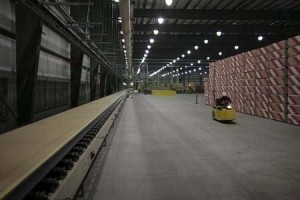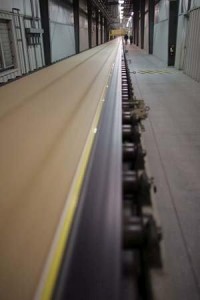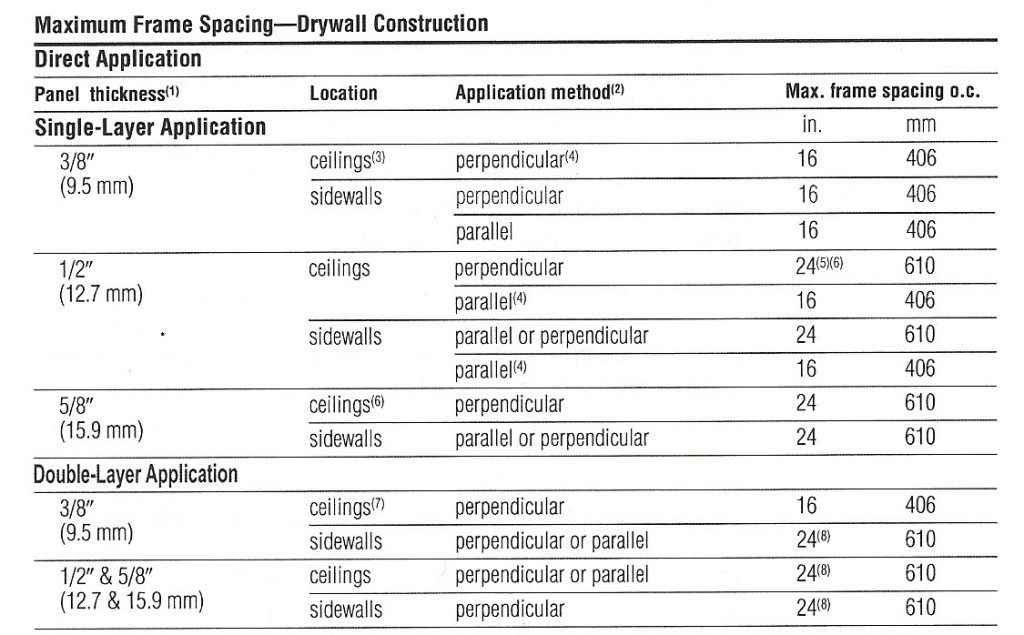About 10 years ago I organized a field trip to a drywall factory. I took my employees, my father, the owner of the local drywall yard, and that’s about it. Turns out visiting a drywall factory is not at the top of most people’s list like it was on mine.
The most interesting thing to me was that after the gypsum core is poured and sandwiched between the two layers of paper the drywall has to set up (cool off) before it can be cut to the desired lengths. I believe that it is this process of pressing the paper faces flat with the liquid gypsum sandwiched between along the length of the drywall is what gives drywall its grain. Just like the grain in wood which gives wood much greater strength with the grain (typically the long direction) than against the grain. Drywall is approximately 3 times stronger in the long direction. Consequently, drywall hung perpendicular to the framing members is stronger than drywall hung parallel. (It is less likely to sag between joists).
Did you ever notice that the recommended on center spacing of ceiling joints is quite often closer when attaching drywall parallel to the joists? see chart below form USG Handbook:
Photo Above: JLC LIve Show: Demonstration on the strength of the lighter weight drywall, which is rated as more resistant to sagging than regular 1/2″ drywall. As a result the lightweight held a lot of weight and still did not break.
In the photo above the strength test was done using regular 1/2″ drywall. Not much sagging occurred before the drywall cut off the end of a panel broke.
Parallel versus perpendicular attachment;
If attached perpendicular to the ceiling joists lengths can be cut so that the butt seams fall where desired (floating, see blog “Eliminating Problems With Butted Seams). Yes we are always trying to avoid butted seams, but an occasional butt seam is better than ridged seams running the length of the ceiling or sagged drywall between joists. Note: The ridged seam could be caused by the beveled edge seam being attached for its length on a low ceiling joist. This happens when hanging drywall parallel to joists. another problem when hanging parallel is less shear strength is added to the assembly compared to hanging perpendicular. In addition drywall hung perpendicular to joists allows the seams to float over slightly uneven joists, making them less conspicuous. (See ridged seam above) .
Can insulation case drywall to sag?
Sagging insulation in ceilings can make properly attaching the drywall impossible. Either staple the insulation up higher along the inside edge of the framing or fur the ceiling. I know this will get a response from some readers, but I don’t like to see the paper flange of Kraft insulation stapled over the face of the framing. The thickness of the paper edge along with the protruding staples creates a problem for fastening. Sagging drywall, poorly attached drywall, and a real increase in fastener pops are a direct result. Make sure the drywall is rated for the framing span. Error on the side of caution by using ceiling board or 5/8 thick drywall. Note: Most drywall manufacturers now make a light weight drywall which is more resistant to sagging that regular drywall. Consider weight of insulation, ½ drywall can support 1.6psf,1/2” ceiling bd can support 2.2 Psf. (Loose fill cellulose is a little over 2 lbs. a sqft for an R 49 value) Note: Other factors to be concerned about is the temperature and humidity of the interior. High moisture content of the air is absorbed into the drywall which can lead to drywall sagging between joists. Also high moisture textures can contribute to problems. So if I haven’t confused you too much you can see that there is a lot to consider when hanging ½” thick drywall on ceilings. But to me the most interesting thing I learned from my trip to the drywall factory was about the grain of drywall and how it affects decisions I make when hanging drywall.



I noticed something while cutting different batches of drywall from the same manufacturer, on some, especially firecode, if you cut it “across” the “grain” (i.e. along the 4′ dimension) you can see little fiberglass threads sticking out when you break it after the score. If cut the other way, you can’t see them stick out.
I did get one batch of 5/8″ firecode that did not have fibers either way, although the gypsum was a darker color. I’m also seeing the fiberglass threads on ultralight a lot. Sometimes I have to pick them out of my hand if I have to carry it that way.
My guess here is that depending on where they get the gypsum, if it’s a really good batch, then they don’t need the fiberglass threads for strength. Or, maybe somebody just forgot to put them in that time.
Cheers
Hi Peter, Most drywall has the fiberglass fibers, especially Fire code drywall. I have not really studied it too much but even the light weight drywall have the fibers. They are there for strength as far as I know. After fire code drywall releases the moisture that is calcified in the gypsum the fibers hold the core together for a while longer which helps achieve the fire rating.
All the best, Myron
I realize this site caters to contractors but you’re of the firsts googlewise so i hope you will answer this. There may be more people that ask about weight limits for hanging stuff on drywall. Thats the question. Im a structural welder/fabricator and make steel art. A toggle can hold 150 lbs (and up to 450 lbs with some different variables) to drywall apparantly but why can you punch a hole in it? How is that possible? I dont feel like peppering a construction worker with all my questions. Haha. What are the basic limits for common problems, household and commercial?
Hi Amy, Typically when anything heavy is going to be attached to a wall it is planned for and backing is installed. If no backing then attach to framing.
If there is no choice but to install a device that only attached to the drywall then I agree that a toggle bolt is best. Drywall is typically not used for structural purposes. But it often does add some shear strength to an assembly. There is a wide variety of drywall panels available. In most cases in residential construction regular 1/2″ drywall is used. You can easily punch a hole through it so it can’t support much weight. In most commercial building 5/8″ drywall is used and that is much stronger. So I would say try and find out what type of drywall you will be attaching to. Who knows it could be it could be 5/8″ impact or abuse resistant drywall which is very strong. Other things to consider is how well the drywall is attached to the framing. Ypu don’t want it pulling away from the wall either.
Your best bet would be to remove a piece of the drywall and install some backing that is attached to the framing.
All the best,
Myron
I am on a commercial job and they want me to hang a 100 pounds on the wall can this be done without wooden studs? The drywall is 5/8 and I’m goi g to use to ogle bolts rated for 150 pounds.
Tv 66 pounds
Mount 30 pounds
Not really sure about hanging that much weight from a toggle. Sounds like you can’t hit a stud. Attaching to steel studs is fine. You could always remove a piece of drywall and install something between the studs to attach to, unless you are worried about disturbing a fire rated assembly
2 January 2017
Hi Myron, Question: you say drywall is approximately 3 times stronger in the long direction than in the short direction. Yet, the single 4×8 sheet in my garage is leaning up against the wall waiting for me to cut a 40” x 25” piece out of it for a ceiling patch. It temporarily rests against the wall, with its short edge on the floor, and the entire sheet has acquired, after a few months, a concave bow from top to bottom.
If the sheet is three times stronger in the long [8’] direction than the short [4’] direction, why doesn’t the bow appear from left to right? Or for that matter, not at all?
Thanks for sharing your knowledge and experience,
Mike Hess
I did a test where the drywall broke with less weight along the 4 ft direction and did not along the long direction. This can be confusing when you look up at a ceiling that is hung perpendicular to the framing, which is the proper direction, because the 4 ft width seems unsupported. But the strength of the long direction prevents sagging. When you look at a ceiling hung parallel it is easier to understand. Myron
Hello there,
I am planning on installing a stone mosaic tile as backsplash in my mobile home. The thickness of the drywall is 1/4 “.
We are looking at cabinets at about 7ft high. The backsplash is about 6 ftx 1 1/2 ft.
Each tile is 5lbs , plus adhesive and grout we are taking about 41 lbs of weights plus cabinets and whatever in in them.
There are two panels of drywall holding the cabinets.
Would they hold the stone tile?
Sorry, I just remeasured my drywall and it is 3/8″.
Hello,
My name is Patricia , and I need help with my new project.
I live in a manufactured home. The walls are 3/8″ thick and are covered with seems to be wallpaper.
I bought mosaic stone mesh mounted tile to put in my backsplash.
But I just realized how much work and preparation has to be done to put the backsplash.
My question is can my 3/8″wall hold the tile , which weights 5lbs per sheet?
Thank you
Patricia
Hi Patricia, The 3/8 drywall is fine because it is just a small area on the wall.
Myron
Building a new house. 1/2″ drywall installed on ceiling with 2′ center rafters. Using cellulose for insulation. Installer mixes a very small amount of moisture in the cellulose. Several people that I trust have advised to use at least 18″ of insulation. Installer says he wouldn’t go above 15″ because of possible sagging problems. How much should I use?
Much Obliged, Dave
Not sure why the insulator is adding water. I have heard of this when installing in walls with no fabric. Drywall can sag on ceilings even with no weight resting on the top. Low temperatures and high humidifies will cause sagging. I recently drywalled a house that had cellulose blown in the ceilings over the drywall when I arrived. It had 1/2″ drywall over 24 inch centers but was left unheated as well as un-taped for over 6 months. It sagged. It still may have sagged but not as much if heated, humidity controlled and taped soon after installing. As I said I think the drywall would have sagged under these conditions even if no insulation was weighing it down. The new lightweight is more say resistant than the old version. I have even seen the lightweight labeled as sag resistant drywall.
Here’s what USG has to say about this issue “To prevent objectionable sag in new gypsum panel ceilings, the weight of overlaid unsupported insulation should not exceed: 1.3 psf for 1/2″-thick panels with frame spacing 24″ o.c.; 2.4 psf for 1/2″ panels on 16″ o.c. framing (or 1/2″ Sheetrock brand interior gypsum ceiling board, sag-resistant on 24″ o.c. framing); 2.2 psf for 5/8″ panels on 24″ o.c. framing.”
National Fiber claims that newer types of cellulose settle to about 1.5 pound per cubic foot.
So, how much cellulose will a drywall ceiling support if we follow the USG recommendation?
1/2″ Sheetrock ceiling, 24″ o.c. – Max. weight of insulation, 1.3 psf ( maybe 10.25 inches of cellulose)
1/2″ Sheetrock ceiling, 16″ o.c. – Max. weight of insulation, 2.4 psf ( maybe 19 inches of cellulose)
5/8″ Sheetrock ceiling, 24″ o.c. – Max. weight of insulation, 2.2 psf (maybe 17.5 inches of newer varieties of cellulose).
I think 24″ o.c. that is furred to 16″ o.c. can support even more because the furring helps with the support.
Keep in mind that all conditions need to be considered
One more thing to consider is that I have hung drywall over kraft faced fiberglass that is face stapled which causes the fiberglass to hang below the joists. This puts a lot of pressure on the drywall which makes it difficult to fasten and can cause sagging.
Hi I live in an apt. It originally was a one bedroom but the owner added a second room before I moved in. I have been trying to hang repurposed pallet shelves that each weigh about 8 lbs on the wall. First attempt was with anchors. It didnt go well. I measured and the drywall is only 1/4 inch thick. Will mollys or toggle bolts work on this? The stud is way off center from the desired area I want to hang the shelf on. Thanks in advance.
I think it is very unusual to use 1/4″ drywall as a single layer over framed walls. It is typically installed over damaged walls that need to be resurfaced. (the damaged wall material is left in place), But if it is the only layer I don’t think it will support much weight. I guess that if you use a large enough toggle bolt it will hold. Maybe use some adhesive to stick the shelve as well as using plenty of toggle bolts
I have a similar question as those above (especially Amy’s): how much weight can I hang on drywall?
In this instance, I am trying to mount some shelves exactly like the ones in the pictures on the Lowe’s site (https://www.lowes.com/pd/Blue-Hawk-0-55-in-W-x-2-12-in-H-x-14-86-in-D-Steel-Wall-Mounted-Shelving/4640141). My tracks are 6 feet long and the shelves themselves are 12″x1″x6′.
In the past I have mounted these to wooden studs with no problems whatsoever and put hundreds of pounds of items on them–books and ceramics primarily.
Now I have moved into a middle-unit townhouse with brick firewalls between units. The drywall seems to be attached to metal furring strips mounted to the brick.
Can I mount the tracks to the metal furring strips or should I put them just on the drywall? If so, should I use toggle bolts or would drywall screws be sufficient? Is there an appropriate length to the screw/bolt?
Or is the combined weight of the shelves and their items likely to pull out the furring strips or cause the drywall to fail?
Thanks for your help in advance! I will never look at drywall the same way again after browsing your site.
The drywall is attached to the metal furring with fine thread drywall screws. The screws only need to penetrate 3/8″ . There are two types of metal furring used . Both are attached to the framing but one has two legs that provide a stronger attachment but offers less sound control. In your case the type with one leg was most likely used. It should still be fine. Just use plenty of screws and be careful not to strip out the screw which is easy to do because the furring is a pretty light gauge. Hundreds of pounds is a lot of weight though.
Hello,
I removed all the lathe and plaster on the first floor of a 120 year old house. Everyone keeps telling me the plaster was a structural element. I updated the structure by doubling up joists, putting in headers etc. There are some areas I just can’t do. My question is, if I use 5/8″ on the walls, as well as the ceiling, would I gain any substantial structural benefit, or would it be marginal?
Not sure about the plaster being structural. Maybe added some sheer strength. 5/8″ is a stronger drywall typically so if worried use the 5/8″. Also using drywall adhesive may add some sheer strength.
Can we hang a 50’ TV on a gypsum wall?
Doesn’t sound like a good idea
Yes go to you tube and you can learn the basics there.I hang for a living so I know there are some overly informative videos but more information is better when you are doing something new.
Good luck!
What thickness drywall do you recommend on a ceiling with trusses spaced 24″ o.c.? My new home will have approximately R-40 blown-in insulation (fiberglass).
I had the truss installers use truss clips to attach the trusses to interior walls – do you also recommend the use of a floating edge at the wall/ceiling junction to avoid cracking? If so, which do you recommend as a fastener at the wall/ceiling interface – the Prest-On Corner Backs or a product such as Trim-Tex Truss Backing Angle?
You can use the lightweight 1/2″ drywall but I prefer to have the ceilings furred to 16″ O C first
I often float the ceiling wall intersection along the center wall and either product works well. But to tell the truth I usually just keep the screws down on the wall and in on the ceiling. Unless the contractor has had problems with truss uplift and hen I will use the Prest-On or Trim-Tex
Wow, thanks for posting this. Interesting to see the “ingredients list” of drywall. We just started our local business Drywall Installation Lancaster PA but I’ve never visited a drywall factory before. Thanks for sharing your experiences!
Thanks, Yeah I sometimes joke that visiting a drywall factory is better than going to Disney. On second thought I’m not really joking.